The OptiX PTN series is a new generation of metropolitan optical transport products developed by Huawei for mobile integrated services, including PTN 3900, PTN 1900, and PTN950, PTN910. Huawei will continue to introduce a variety of high-end PTN products and low-end box PTN products for mobile bearer network service delivery solutions for ALL IP and future integrated mobile phone convergence (FMC), supporting MSTP to packet transfer networks. Smooth evolution.
1. Its full packet architecture design accommodates future ALL IP delivery to meet new IP service requirements;
2. PW technology for multi-service access, which enables integrated carrier 2G/3G/LTE services;
3. Carrier-class design: Packet clock synchronization mechanism with the same frequency and in-phase, SDH-Like end-to-end service deployment capabilities, OAM and service protection capabilities, and hierarchical and connection-oriented QoS service assurance mechanisms.
PTN series products use comprehensive MPLS/PWE and MPLS-TP technologies to realize comprehensive bearer of mobile services. Large-scale deployment of VPLS, VPWS leased line, and L3VPN customer line can be implemented on a large scale. The QoS mechanism and hierarchical QoS deployment capability are well established. Bandwidth statistics multiplexing capability; powerful hardware OAM mechanism to achieve rapid detection of faults and 50ms fast protection switching of batch services. With the T2000 network management system to provide a powerful graphical interface management, end-to-end business configuration and management capabilities, PTN products can achieve rapid fault location, ensure that the PTN packet network can be operational and manageable.

1. The adoption of packet transmission technology can solve the operators' need for ever-increasing bandwidth requirements and bandwidth scheduling flexibility of the transmission network.
2. Using PWE3 (Pseudo Wire Emulation Edge to Edge) technology to achieve connection-oriented service bearer.
3. Support access to base station services in various forms such as TDM (Time Division Multiplexing) E1, MA (Inverse Multipl exing over ATM) E1, FE (Fast Ethernet), and GE (Gigabit Ethenet). Supports the smooth evolution of mobile communication bearer networks from 2G to 3G.
4. Adopt MPLS (Multi-Protocol Label Switch) forwarding technology optimized for telecommunication bearer, complete with OAM (Operation Administration and Maintenance), QoS (Quality of Service) and protection switching mechanism, and use packet transport network to implement telecommunication-level services. Bearer.
5. Support Ofload solution, which distributes bearer services such as HSDPA (High Speed ​​Downlink Packet Access) and R99, and connects xDSL (x Digital Subsidiber Line) boards with leased networks to transmit HSDPA services, reducing transmission costs.
6, small size, light weight, low deployment costs, can be installed in the cabinet, the wall and the desktop.
Huawei PTN910 Interface Board SpecificationsThe configurable parameters of the Huawei PTN910 interface board are: Ethermet interface, PDH interface, ADSI interface, G.SHDSI interface, SDH interface, channel configuration, J0, J1, J2, C2, V5, laser auto-shutdown, idle time slots Recovery value.
The Ethermet interface configuration includes basic attributes, Layer 2 attributes, Layer 3 attributes, ** attributes, and flow control. It mainly configures the physical parameters of the port, the parameters of the link layer, the parameters of the network layer, and the flow control methods.
The PDH interface configuration includes basic attributes, three-layer attributes, and ** attributes. It configures the physical parameters of the port, network layer parameters, signal frame format, clock mode, and loopback mode.
ADSL interface configuration includes the basic attributes of the interface, the VPIVCI of the interface, and the Tumne enable of the virtual interface.
The G.SHDSI interface configuration includes basic attributes and interface modes (including ATM mode, EFM mode, and IMA mode).
The SDH interface configuration includes basic attributes, Layer 2 attributes, Layer 3 attributes, and ** attributes. It mainly configures the physical parameters of the port, the parameters of the link layer, and the parameters of the network layer.
The Huawei PTN910 channel configuration includes the VC12 frame format and frame mode for configuring the channelized SDH interface.
The J0 byte is used to repeatedly send the segment access point identifier so that the receiver can confirm that it is in continuous connection with the designated transmitter.
J1 is the channel trace byte. Its role is that the sender continuously sends this byte a high-order access point identifier so that the receiver can confirm that the specified sender is in continuous connection. The receiver detects J1 mismatch and the corresponding channel generates the HP.TM alarm.
J2 is the VC-12 channel trace byte, which is used to repeatedly send the contents of the low-order channel access point identifier negotiated by the receiving and sending ends, so that the receiving end can confirm and the transmitting end is continuously connected on this channel _. status.
C2 is a signal tag byte, and its role is to indicate the multiplexing structure of the VC frame and the nature of the information payload, requiring that the transceivers match. If the C2 byte is mismatched, the HP_SLM alarm is generated on the corresponding VC-4 channel at the local end.
Huawei PTN910 clock interface indicatorsThe technical specifications of the Huawei PTN910 include overall specifications, system indicators, and single-board indicators and performance indicators. Here we introduce Huawei's PTN910 clock interface indicators.
The clock interface and synchronization performance of the Huawei PTN910 comply with the ITU-T standard.
Clock/time interface type:Huawei PTN910 devices provide external clock/time input interfaces and clock/time output interfaces. As shown in Table 1.

Table 1 Description of the clock/time interface of the Huawei PTN910
Timing and synchronization performance:The timing and synchronization performance of the Huawei PTN910 device meets the requirements of the ITU-T G.813 standard.
Timing and synchronization performance are shown in Table 2.

Table 2 timing and synchronization performance
Huawei ptn910 network application 1, network statusThe OptiX PTN 910 is placed on the radio base station side, and converts the service output from the base station to a sink node.
Figure 1-2 shows the typical networking of the OptiX PIN 910. The OptiXPTN910 accesses services from the base station through TDME1, IMAE1, or FE interfaces. PTN devices use ML-PPP (VC-12 in E1 or cSTM-1), packet microwave, FE, or GE interface networking. When renting a third-party network, the OptiX PIN910 connects to an xDSL network through an xDSL interface, or a third-party Ethernet network through an FE/GE interface, and transmits the mobile service to the aggregation node through the xDSL/Ethernet network. The OptiX PTN 3900/1900 on the BSC (Base Station Controller)/RNC (Radio Network Contoller) side converges services and connects to the BSCRNC.
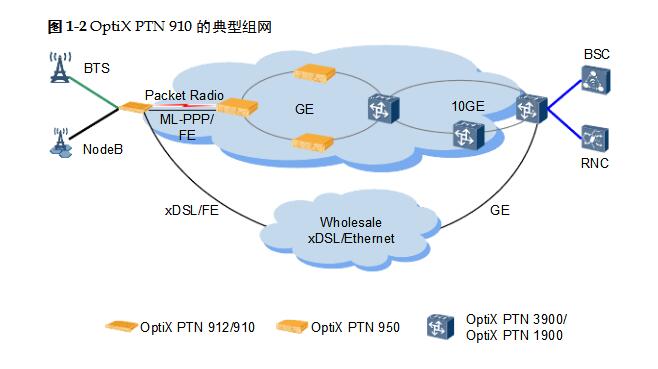
The typical application of the OpiX PIN 910 is the backhaul service between the BTS/NodeB side of the mobile communication and the BSC/RNC and is carried by the PTN device network. Application scenarios are shown in Table 1-1.
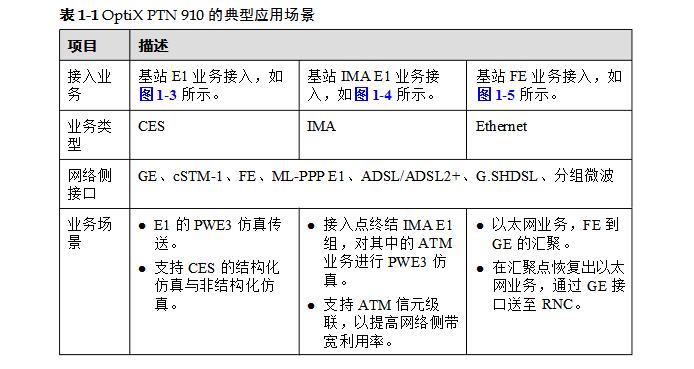
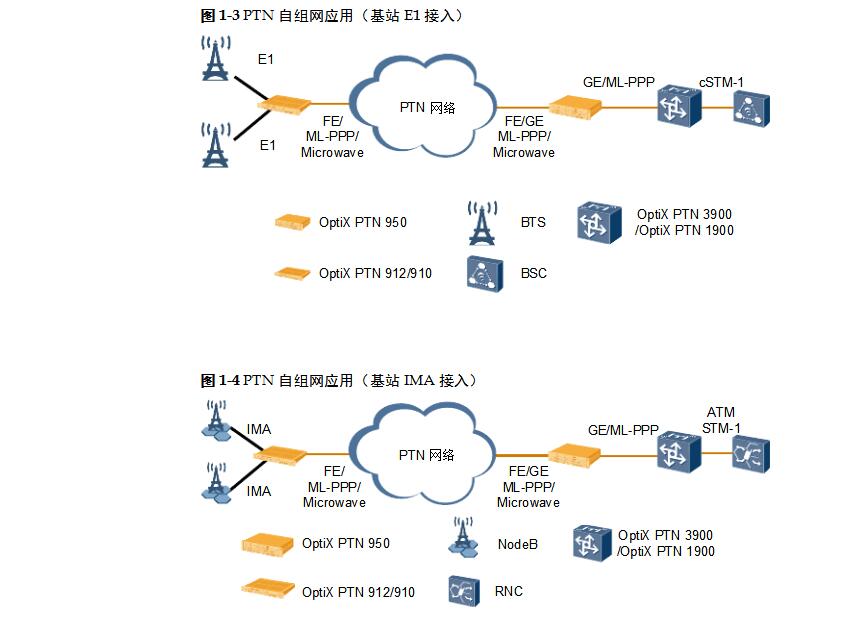
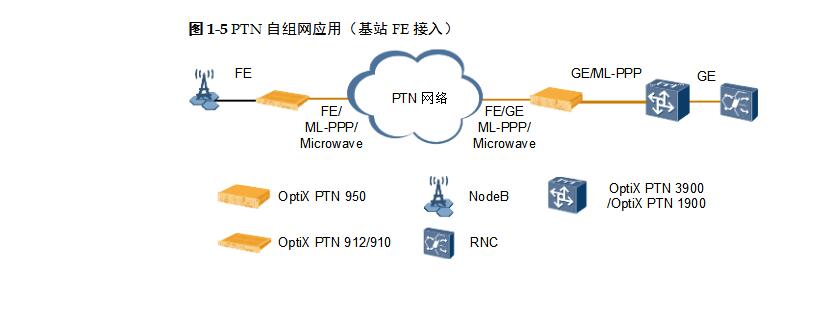
For the service transmission between NodeB and RNC in 3G mobile communication, the PTN product can divert HSDPA (High Speed ​​Downlink Packet Access) service out of the network and carry it through a low-cost access and forwarding network (such as an ADSL network). Transmission costs increase the competitiveness of mobile operators. The application scenario is shown in Figure 1-6.
The services sent by the NodeB are transmitted to the access site through IMAE1, and the aggregation site is connected to the RNC through the ATMSTM-1 interface.
For the signaling flow and R99 traffic flow, the access site transmits it over the leased line to the aggregation site.
For the HSDPA service flow, the access site carries out a series of encapsulation and transmits it to the aggregation site through the xDSL network.
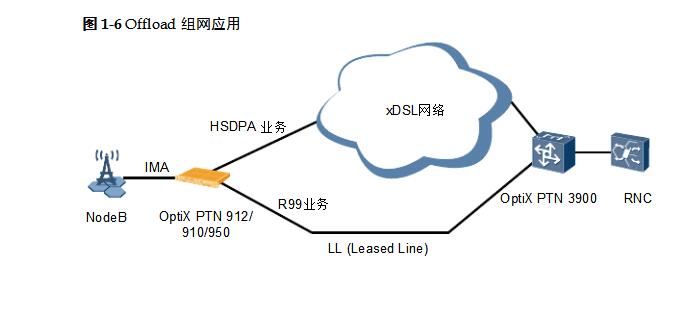
10 inch tablet is the most important size on tablet market. Which kind of clients like more? The answer is loving bigger size or storage, longer working time, etc. Since Android Tablet 10 inch is usually equipped with full HD screen, memory support up to 8GB, storage up to 256GB, battery up to 7000mAh-working 5-8hours. However, 8 inch android tablet mainly up to 4GB ram 64GB ROM, 4000mAh battery. At this store, you can see more than ten different 10 inch tablets on sale and one 10 inch windows tablet with magnetic keyboard option, and high level CPU and SIM Card option. Besides, you can also see amazon tablet 10 inch with competitive cost, especially take above 1000pcs. Except android tablet, 14 inch 64Gb Student Laptop for online learning, 15.6 inch celeron n5095 business laptop, 15 inch intel i3, i5, i7 10th or 11th generation Gaming Laptop and 16 inch laptop with 4gb graphics card and 16gb ram 512GB ssd alternatives also.
Any other special requirements, just fee free to contact us. Will try our best to support you.
10 Inch Tablet,10 Inch Tablets On Sale,Android Tablet 10 Inch,Amazon Tablet 10 Inch,10 Inch Windows Tablet
Henan Shuyi Electronics Co., Ltd. , https://www.shuyicustomtablet.com